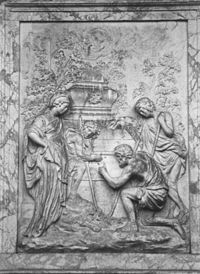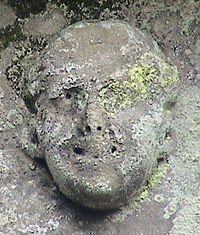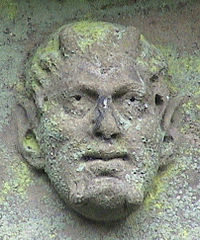- Shugborough inscription
-
The Shugborough inscription is a sequence of letters - O U O S V A V V, between the letters D M - carved on the 18th-century Shepherd's Monument in the grounds of Shugborough Hall in Staffordshire, England, below a mirror image of Nicolas Poussin's painting, the Shepherds of Arcadia. It has never been satisfactorily explained, and has been called one of the world's top uncracked ciphertexts.[1] The inscription became widely known after being mentioned in the 1982 book The Holy Blood and the Holy Grail by Michael Baigent, Richard Leigh, and Henry Lincoln.
Contents
The Monument
The monument was built sometime between 1748 and 1763, commissioned by Thomas Anson, paid for by his brother, Admiral George Anson, and fashioned by the Flemish sculptor Peter Scheemakers. The relief copy of the Poussin painting is contained within a rustic arch, and shows a woman and three shepherds, two of whom are pointing to a tomb. On the tomb is carved the Latin text Et in arcadia ego ("I am also in Arcadia" or "I am, even in Arcadia"). The carving displays a number of small alterations from the original painting, and an extra sarcophagus has been placed on top of the main tomb. Above the Poussin scene are two stone heads, one showing a smiling bald-headed man, the other bearing a likeness to the goat-horned Greek god Pan.
Below the relief carving on the monument, an unknown craftsman carved the mysterious eight letters, contained within the letters 'D M' On Roman tombs, the letters 'D M' commonly stood for Diis Manibus, meaning "dedicated to the shades".
Theories
Josiah Wedgwood, Charles Darwin and Charles Dickens are all said to have attempted to solve the enigma and failed.[2]
No solution has yet been proposed which rests on a solid cryptanalytic footing.
However, in recent decades, investigators have proposed several possible solutions. Some of these are acrostic, interpreting each letter as the initial letter of a word.
- One suggestion is that the eight letters are a coded dedication by George Anson to his deceased wife. In 1951 Morchard Bishop speculated that the letters might be an acronym for the Latin phrase Optimae Uxoris Optimae Sororis Viduus Amantissimus Vovit Virtutibus ("Best of wives, Best of sisters, a most devoted Widower dedicates (this) to your virtues").[3]
- Steve Regimbal interprets the letters as standing for a new Latin translation of the phrase "Vanity of vanities, saith the preacher; all is vanity." (Ecclesiastes 12:8), namely Orator Ut Omnia Sunt Vanitas Ait Vanitas Vanitatum. He has speculated that the phrase may be the source of the earlier inscription "OMNIA VANITAS" which may have been carved on an alcove at the estate of one of Thomas Anson's associates, George Lyttleton[4]
- Margaret, Countess of Lichfield has claimed that the inscription was a love message, referring to the lines Out Your Own Sweet Vale, Alicia, Vanishes Vanity. Twixt Deity and Man Thou, Shepherdess, The Way, but no source for these words has ever been traced.[3]
- A. J. Morton observes that some of the letters match the names of the residents of Shugborough in the early 19th century, and believes that the inscription denotes the words: Orgreave United with Overley and Shugborough, Viscount Anson Venables Vernon[5]
Non-acrostic efforts include:
- a work by Peter Oberg where the letters stand for numbers which sum to 2810, the distance in miles 2810 miles from Shugborough to the so-called "Money Pit" on Oak Island, in Nova Scotia, Canada.
- a suggestion that relies on pronouncing 'UOSV' as 'Iosef', interpreted as a reference to the biblical prophet Joseph.
- a proposal that 'VV' should be read as 'TEN', with reference to Roman numerals, and the 10 letters then read as an anagram of 'DEVOUT MASON'.
Priory of Sion and the Holy Grail
In 1982, the authors of the pseudohistorical The Holy Blood and the Holy Grail suggested that Poussin was a member of the Priory of Sion, and that his Shepherds of Arcadia contained hidden meanings of great esoteric significance.
In 2003, Dan Brown developed similar themes in his bestselling novel The Da Vinci Code, and in 2004 Richard Kemp, the general manager of the Shugborough Estate, launched a promotional campaign which asserted a connection between Shugborough, and in particular the Shugborough inscription, and the Holy Grail.
Speculation then grew that the inscription may encode secrets related to the Priory of Sion,[6] or the location of the Holy Grail. As part of the Shugborough promotion, some individuals who had previously worked as codebreakers at Bletchley Park pursued this line of investigation. Oliver Lawn proposed that the letters may encode the phrase Jesus H Defy, where the H supposedly stands for "Christos" (Greek for "Messiah") and the reference is to a Jesus bloodline which allegedly descends from a non-divine Jesus and was preserved by the Priory.[2] Sheila Lawn, his wife, preferred the love story theory. Despite the couple's previous employment, neither of their suggestions enjoyed reliable cryptanalytic support and both were presented as speculative.
Notes
- ^ Belfield, Richard (August 2007). The Six Unsolved Ciphers: Inside the Mysterious Codes That Have Confounded the World's Greatest Cryptographers. Ulysses Press. ISBN 1-5697-5628-7.
- ^ a b Tweedie, Neil (2004-11-26). "Letters remain the holy grail to code-breakers". London: The Daily Telegraph. http://www.telegraph.co.uk/news/uknews/1477527/Letters-remain-the-holy-grail-to-code-breakers.html. Retrieved 2008-11-25.
- ^ a b "The Shepherd's Monument". Staffordshire County Council. http://www.shugborough.org.uk/AcademyShepherdsMon-169. Retrieved 2008-11-25.
- ^ Andrew Baker. "Hidden Meanings?". http://www.heardmusic.co.uk/page.asp?pid=93. Retrieved 2011-03-14.
- ^ "Shepherd's Monument 'code' was 19th century graffiti". Daily Telegraph. 2011-02-01. http://www.telegraph.co.uk/news/newstopics/religion/8295174/Shepherds-Monument-code-was-19th-century-graffiti.html#. Retrieved 2011-03-01.
- ^ "Code points away from Holy Grail". BBC. 2004-11-26. http://news.bbc.co.uk/1/hi/england/beds/bucks/herts/4040127.stm. Retrieved 2008-11-25.
External links
- 2011 Da Vinci Code Riddle SOLVED
- The Final Solution of The Shepherd Monument
- www.templarstreasure.com
- Images of the monument
- The Changing Face of Poussin's Pentagon, by Geoff Bath
- Shugborough Hall and the Holy Grail, by Graham Phillips
- New puzzle for war code breakers (BBC)
- Bletchley veterans tackle 'toughest puzzle yet' (The Guardian)
- Da Vinci Code at Shugborough Hall (BBC)
- Holy Grail 'clue' at stately home (The Times)
- The Solution to the Shugborough code and the location of the Holy Grail
Categories:- History of cryptography
- Modern Latin inscriptions
- Inscriptions of disputed origin
- Alleged tombs of Jesus
- Uncracked codes and ciphers
- Visitor attractions in Staffordshire
Wikimedia Foundation. 2010.






